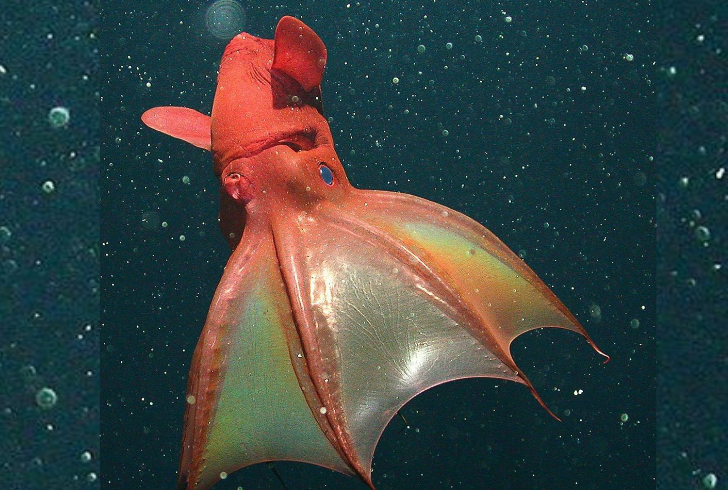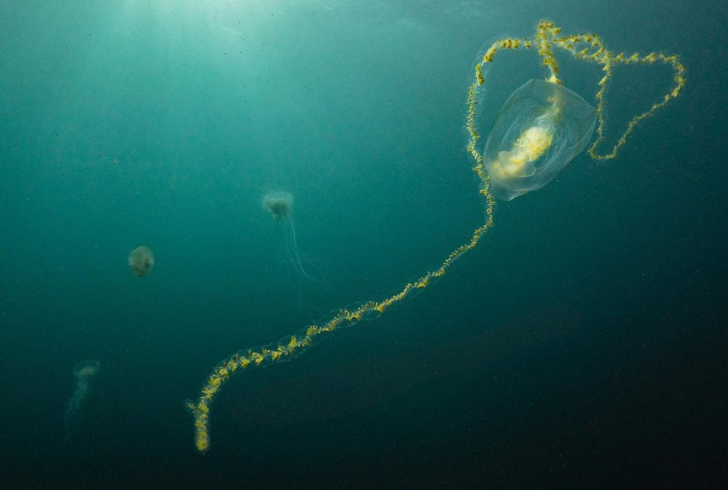The ocean, an expanse filled with enigmatic mysteries, is home to some of the strangest looking sea creatures ever imagined. Each corner of this vast aquatic world reveals bizarre life forms that defy conventional understanding. From eerie anglerfish to peculiar sea slugs, these underwater beings are as fascinating as they are peculiar.
Here’s a closer look at thirteen of the most peculiar sea creatures that call the deep blue sea their home.
Weirdest and Strangest Looking Sea Creatures
1. The Dumbo Octopus
The Dumbo octopus stands out with its distinctive, ear-like fins that evoke the famous cartoon elephant from which it takes its name. This intriguing cephalopod thrives in the deep ocean, with some sightings recorded as deep as 7 kilometers below the surface in the Indian Ocean’s Java Trench. These elusive creatures are a prime example of how life adapts to extreme environments, showcasing a unique form of locomotion and a delicate, translucent body that contributes to their otherworldly appearance.
2. The Gulper Eel
The gulper eel, or pelican eel, presents a strikingly odd appearance with its incredibly expandable jaws. These eels possess a mouth that can open wide enough to engulf prey nearly as large as themselves. This extraordinary feature allows them to capture small fish and crustaceans efficiently. When feeding, their heads balloon dramatically, showcasing one of the most dramatic feeding mechanisms found in the ocean.
3. The Vampire Squid

Instagram | oceana | The vampire squid thrives in the deep ocean's oxygen-poor environment.
With a name that sounds like it belongs in a horror movie, the vampire squid lives up to its reputation. Despite its name, it is neither a true squid nor a vampire but rather a unique cephalopod known as Vampyroteuthis infernalis. It is characterized by its dark color and webbed arms that give it a ghostly appearance. This deep-sea creature is specially adapted to live in oxygen-poor environments, making it one of the strangest looking sea creatures.
4. Johnson's Abyssal Seadevil
If there were a contest for the most intimidating sea creature, Johnson's abyssal seadevil would certainly be a top contender. This deep-sea anglerfish features needle-sharp teeth and a bioluminescent lure used to attract prey in the pitch-black depths of the ocean. Its ability to expand its stomach to accommodate large prey makes it a formidable predator in its dark, hostile habitat.
5. The Costasiella Sea Slug
Often referred to as the "leaf sheep," the Costasiella sea slug is as peculiar as it is fascinating. This slug not only resembles a cartoon sheep but also exhibits a rare ability among animals: photosynthesis. By incorporating chloroplasts from the algae it consumes into its own tissues, it gains a part-plant characteristic, allowing it to harness the power of sunlight.
6. The Emperor Shrimp
Brightly colored and adorned with a vibrant palette, the emperor shrimp is an unmistakable sight. This shrimp lives symbiotically with sea slugs, providing cleaning services in exchange for protection. Its striking appearance and unique lifestyle make it one of the most memorable members of the strange sea creatures category.
7. The Giant Isopod
Imagine a woodlice the size of a small dog, and you might picture a giant isopod. These large crustaceans live in the deep ocean, scavenging for whatever organic material they can find. Despite their intimidating size, they play a crucial role in the deep-sea ecosystem by cleaning up detritus from the ocean floor.
8. The Sea Pig
The sea pig, a type of sea cucumber, has a somewhat comical appearance with its plump, pink, and rounded body. These creatures use specialized tubular legs to crawl across the ocean floor, feeding on decaying material. Their hydraulic movement system and unique shape make them a fascinating subject of study in marine biology.
9. The Doto Greenamyeri Nudibranch
The Doto greenamyeri nudibranch is a tiny, colorful sea slug with a remarkable appearance. Covered in protective, eye-catching protuberances known as cerata, this creature uses these features for defense and respiration. Though small, its vibrant and peculiar look makes it a standout among the ocean’s oddities.
10. The Polychaete Worm
Living on deep-sea hydrothermal vents, the polychaete worm boasts an impressive array of sensory hairs that resemble a fantastical toupee. This worm is part of a vast family of bristle worms, each with unique adaptations for survival in extreme conditions, showcasing the diversity and adaptability of marine life.
11. The Giant Siphonophore

Instagram | underwaterpat | The giant siphonophore is one of the longest animals, reaching over 40 meters.
The giant siphonophore is not a single creature but rather a colony of specialized individuals working together. Growing up to 40 meters long, this colonial organism functions as a single entity with members dedicated to capturing food, digesting it, and reproducing. This unique structure is an example of nature’s creativity in forming complex life forms.
12. The Angelshark
The angelshark is a flat, ray-like shark that blends seamlessly with the ocean floor. Its flattened body and large fins make it an effective ambush predator, allowing it to lie buried in the sand and surprise prey that comes too close. Its unusual shape and behavior add to the list of strangest looking sea creatures.
13. The Bobbit Worm
The Bobbit worm is a fearsome predator known for its extraordinary hunting technique. Buried in the sand with only its tentacles exposed, it waits for unsuspecting prey to come near. With a sudden, powerful strike, it seizes its prey, often slicing it in half. This worm’s predatory efficiency and hidden lifestyle make it a striking example of the ocean’s more dangerous residents.
Exploring the ocean's depths reveals a world full of bizarre and captivating creatures. Each of these strange sea creatures demonstrates the incredible adaptability and diversity of life in the underwater world. Whether it’s the bioluminescent lure of the abyssal seadevil or the peculiar photosynthetic capabilities of the Costasiella sea slug, these marine oddities continue to fascinate and inspire curiosity.





